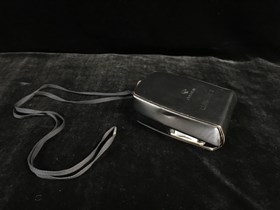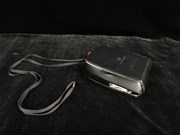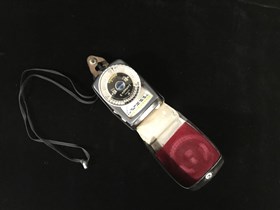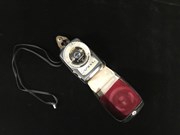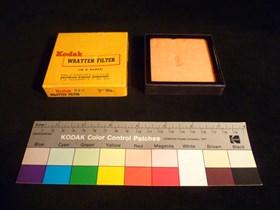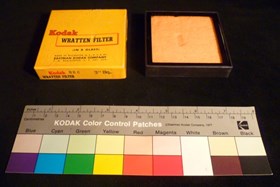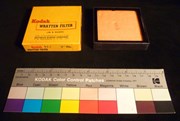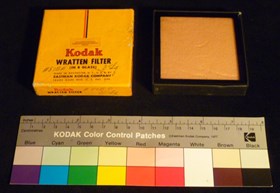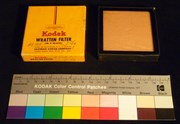- Date
- 1933 – 1949
- Material
- plastic; paint; leather; metal; fabric
- Catalogue Number
- 104.41.1123 a-b
- Description
- (a)Gossen Lunasix exposure and colour meter in a pear shape with leather case. The light meter device measures the amount of light that is appropriate to achieve the proper exposure, indicating for the users which shutter speed and f-number should be selected. Along the top of the exposure meter in…
1 image
- Title
- Exposure Meter
- Date
- 1933 – 1949
- Material
- plastic; paint; leather; metal; fabric
- Dimensions
- (a)2.5; (b)04.5 x (a)6.5; (b)7.5 x (a)11.5; (b)12.0 cm
- Description
- (a)Gossen Lunasix exposure and colour meter in a pear shape with leather case. The light meter device measures the amount of light that is appropriate to achieve the proper exposure, indicating for the users which shutter speed and f-number should be selected. Along the top of the exposure meter in the viewer left corner is a white bulb-like part next to an open circular window that measures the amount of light present in the scene. When the converter slide, located along the viewer right side, is moved to the right and clicked into position the round window is open and ready to read the scene. At the top, on the face of the meter, the light measurement (scale) is present. This shows how much light is present in the scene and directly relates to the remaining scales on the meter. Below the light scale is a plexiglass film-speed setting disc with grooves that allow the operator to easily move the dial. In the middle of the dial there is the Lunasix manufacturer symbol. On viewer left side of this emblem is the DIN exposure index of the film in use; on the proper right side of this emblem is the ASA exposure index of the film in use. By moving the dial one adjusts the film-speed setting, which is indicated in the DIN and ASA boxes, whereby the index number is lined up against the triangular white marker in the respective window. A manual would have originally been sold with the object giving a more comprehensive overview of the film-speed table with a technical appendix. On the rear of the object in the viewer right corner one will see the correct position of the 2 batteries indicated through a tiny diagram. Below this is a metal battery chamber. Below this are the words “2 Batt. Mallory” “PX 625 o. PX 13”. To the viewer left of this writing is the ridged slide used for battery testing. Above the ridged slide are the words “Batt. Contr.” with a solid arrow below. Below the battery information is the table of footcandle (LUX) equivalents. In the middle of the table is the zero adjustable screw with an arrow pointing in both directions. AT the very bottom painted on the surface is the location of manufacturing; “GERMANY (WEST)” above a cutout window revealing the patent number; “4D01673”. (b) There is also a black leather case with the object. The inside of the case has gray suede lining, which would have helped avoid scratching and marking of the meter. The case has been carefully designed to retrofit the meter, which is apparent through the tiny leather strap present when the case is opened. These designs allow the object to be formly held into place further safeguarding it. At the bottom of the case there is a black button that allows the case to be opened and fastened shut. When the case is fastened shut, the name of the manufacturer “Gossen” appears imprinted and is upside down. Below this, also upside down, “LUNASIX 3” has been applied in silver ink. Along the viewer right side the case has a cutout that perfectly fit the converter slide. On the rear “MADE IN GERMANY” appears in a receded box with protruding lettering. The bottom of the case, where the button is located, contains an opening for the black string to be strung through. The string, which has been tied to the exposure meter, measures 49.0 cm and has a metal piece holding the ends of the string in place. This would have given the user greater security when working with the exposure meter.
- Subject
- photography
- Nick Morant
- Credit
- Gift of Nicholas Morant, Banff, 2006
- Catalogue Number
- 104.41.1123 a-b
Images
This material is presented as originally created; it may contain outdated cultural descriptions and
potentially offensive content.
Read more.
- Date
- 1933 – 1949
- Material
- plastic; metal; leather; paint; fabric
- Catalogue Number
- 104.41.1124 a-b
- Description
- (a)Gossen Lunasix exposure and colour meter in a pear shape with leather case. The light meter device measures the amount of light that is appropriate to achieve the proper exposure, indicating for the users which shutter speed and f-number should be selected. Along the top of the exposure meter in…
1 image
- Title
- Exposure Meter
- Date
- 1933 – 1949
- Material
- plastic; metal; leather; paint; fabric
- Dimensions
- (a)2.5; (b)04.5 x (a)6.5; (b)7.5 x (a)11.5; (b)12.0 cm
- Description
- (a)Gossen Lunasix exposure and colour meter in a pear shape with leather case. The light meter device measures the amount of light that is appropriate to achieve the proper exposure, indicating for the users which shutter speed and f-number should be selected. Along the top of the exposure meter in the viewer left corner is a white bulb-like part next to an open circular window that measures the amount of light present in the scene. When the converter slide, located along the viewer right side, is moved to the right and clicked into position the round window is open and ready to read the scene. At the top, on the face of the meter, the light measurement (scale) is present. This shows how much light is present in the scene and directly relates to the remaining scales on the meter. Below the light scale is a plexiglass film-speed setting disc with grooves that allow the operator to easily move the dial. In the middle of the dial there is the Lunasix manufacturer symbol. On viewer left side of this emblem is the DIN exposure index of the film in use; on the proper right side of this emblem is the ASA exposure index of the film in use. By moving the dial one adjusts the film-speed setting, which is indicated in the DIN and ASA boxes, whereby the index number is lined up against the triangular white marker in the respective window. A manual would have originally been sold with the object giving a more comprehensive overview of the film-speed table with a technical appendix. On the rear of the object in the viewer right corner one will see the correct position of the 2 batteries indicated through a tiny diagram. Below this is a metal battery chamber. Below this are the words “2 Batt. Mallory” “PX 625 o. PX 13”. To the viewer left of this writing is the ridged slide used for battery testing. Above the ridged slide are the words “Batt. Contr.” with a solid arrow below. Below the battery information is the table of footcandle (LUX) equivalents and is only for incident light. In the middle of the table is the zero adjustable screw with an arrow pointing in both directions. AT the very bottom painted on the surface is the location of manufacturing; “GERMANY (WEST)” above a cutout window revealing the patent number; “289337”. (b) There is also a black leather case with the object. The inside of the case has gray suede lining, which would have helped avoid scratching and marking of the meter. Some of this material must have worn away throughout the life of the case, as a red section of suede has been added to the case. The case has been carefully designed to retrofit the meter, which is apparent through the tiny leather strap present when the case is opened. These designs allow the object to be firmly held into place further safeguarding it. At the bottom of the case there is a black button that allows the case to be opened and fastened shut. When the case is fastened shut, the name of the manufacturer is protruding and reads: “GOSSEN”, which appears in the middle of a recessed circle. Below this, also upside down, “LUNASIX 3” is imprinted in protruding letters. Along the viewer right side the case has a cutout that perfectly fit the converter slide. On the rear “MADE IN GERMANY” appears in a receded box with protruding lettering. The bottom of the case, where the button is located, contains an opening for a black string to be strung through, which is also attached to the meter. The string, which has been tied to the bottom of the exposure meter, measures 49.0 cm and has a metal piece holding the ends of the string in place. This would have given the user greater security when working with the exposure meter.
- Subject
- Nick Morant
- Credit
- Gift of Nicholas Morant, Banff, 2006
- Catalogue Number
- 104.41.1124 a-b
Images
This material is presented as originally created; it may contain outdated cultural descriptions and
potentially offensive content.
Read more.
- Date
- 1940 – 1960
- Material
- glass; paper
- Catalogue Number
- 104.41.1128 a-c
- Description
- Kodak 3-inch square filter with original box. (a) The original box consists of a top (lid) and a bottom. The top of the yellow coloured box is square and measures 8.2cm x 8.2cm, which is slightly larger than the 3-inch filter allowing the box to safely store the object. On the face of the lid “Koda…
1 image
- Title
- Filter
- Date
- 1940 – 1960
- Material
- glass; paper
- Dimensions
- (a) 1.9; (b) 1.7; (c) 0.425 x (a) 8.3; (b) 8.0; (c) 7.6 x (a) 8.3; (b) 8.0; (c) 7.6 cm
- Description
- Kodak 3-inch square filter with original box. (a) The original box consists of a top (lid) and a bottom. The top of the yellow coloured box is square and measures 8.2cm x 8.2cm, which is slightly larger than the 3-inch filter allowing the box to safely store the object. On the face of the lid “Kodak” has been written inside of a red coloured box, which is attached to a black coloured box with the word “filter” written inside. Below this “3-INCH SQUARE” has been (machine) printed in black lettering. Along the viewer left and right sides of the box a half circular cutout is present to allow for easier removal of the box’s lid. Much like the face of the box lid, the front side of the box also has the company name “Kodak” written inside of the red coloured box, which is attached to a black coloured box with the word “filter” printed inside. Next to the company and product names “3-INCH SQUARE” is (machine) printed in black lettering. Below this an ink stamp has been applied, possibly by Nick himself, and reads: “N.D.03.” This stamp has been smudged slightly distorting the mark, although it is still legible. This code symbolizes the colour of the filter, which is a deep neutral slightly warm grey colour that has a neutral density to reduce very bright sunlight, which has a fine mark from bonding agent breakdown. The back of the lid has all of the manufacturer information in red which reads: “EASTMAN KODAK COMPANY” “MADE IN ROCHESTER N.Y. U.S.A. T.M. REGISTERED U.S. PAT. OFF.” On the inside of the lid, on the same side as the manufacturer information, “Code No. 4767” “KP 51378” “printed in U.S.A.” has been (machine) printed. When looking at the inside of the lid it becomes apparent that the information on the boxes lid would have been printed as a whole on the glossy-style paper before being adhered to the cardboard lid. (b)The bottom of the filter’s case is made from plain black cardboard that contains no writing. The inside of the box’s bottom does have a cushioned material that would have supported the object and eliminated any concerns of scratching. (c) The Kodak filter would have been used for printing onto UV sensitive papers. The glass filter absorbs light and only transmits the UV radiation to sharpen prints. The filter measures approximately 7.6cm or 3-inches. Around the edges of the clear glass is a black border. At the top of the border the words: “DEN. 0.30” has been painted in gold, which represents the colour code of the filter. Along the bottom of the border the letter “V” has been painted in gold. This information has also been written on the reverse of the object.
- Subject
- photography
- Nick Morant
- Credit
- Gift of Nicholas Morant, Banff, 2006
- Catalogue Number
- 104.41.1128 a-c
Images
This material is presented as originally created; it may contain outdated cultural descriptions and
potentially offensive content.
Read more.
- Date
- 1940 – 1960
- Material
- glass; paper; ink
- Catalogue Number
- 104.41.1129 a-c
- Description
- Kodak 3-inch square Wratten filter with original box.(a) The original box consists of a top (lid) and a bottom. The top of the yellow coloured box is square and measures 8.2cm x 8.2cm, which is slightly larger than the 3-inch filter allowing the box to safely store the object. The face of the lid c…
1 image
- Title
- Filter
- Date
- 1940 – 1960
- Material
- glass; paper; ink
- Dimensions
- (a) 1.9; (b) 1.7; (c) 0.425 x (a) 8.3; (b) 8.0; (c) 7.6 x (a) 8.3; (b) 8.0; (c) 7.6 cm
- Description
- Kodak 3-inch square Wratten filter with original box.(a) The original box consists of a top (lid) and a bottom. The top of the yellow coloured box is square and measures 8.2cm x 8.2cm, which is slightly larger than the 3-inch filter allowing the box to safely store the object. The face of the lid contains the following words: “Kodak” “WRATTEN FILTER” “(IN B GLASS)” which has been (machine) printed. Below this the manufacturer information has been printed and reads: “MADE IN ROCHESTER, N.Y., U.S.A. BY” “EASTMAN KODAK COMPANY” “T.M. REGISTERED U.S. PAT. OFF.” Along the viewer left and rights side of the box a half circular cutout is present to allow for easier removal of the box’s lid. Both the front and back of the box has the company name, “Kodak” “WRATTEN FILTER” (machine) printed. An ink stamp has been hand applied, possibly by Nick Morant himself, to both the front and back of the box`s edges and reads: “85C” “3** Sq.” “Code 4417” “KP 34344B” “Printed in U.S.A.” in black letters. The code 85C represents the colour code, which would have been a light orange and would have helped correct bluish casts that often occur when photographing outdoors. The 85C series filter would have decreased the colour temperature from 5500-3800 degrees Kelvin. When looking at the inside of the lid it becomes apparent that the original material used for the structural security of the box would have been covered in a paper that would have had the information, specified above, printed on glossy-style paper before meticulously being adhered to the lid. Also on the inside of the lid in blue pen “85-C Daylite Filter for Type F Kodachrome on Ektachrome Type F`s.” has been written, possibly by Nicholas Morant. (b) The bottom of the box has the plain white cardboard with a black covering that contains no writing. The inside of the box’s bottom no longer has the original cushioned material that would have supported the object. Several folded and layered pieces of cotton-style tissue have been neatly ordered to prevent scratching to the objects’ surface. (c) The Kodak filter would have been used for printing onto UV sensitive papers. The glass filter absorbs light and only transmits the UV radiation to sharpen prints. The filter measures approximately 7.6 cm or 3 inches. Around the edges of the clear glass is a black border. At the top of the border the words: “FILTER NO. 85C” has been painted in gold. Along the viewer left side of the object there is also three straight lines in gold. Both of these patterns are mirrored on the reverse of the filter.
- Subject
- photography
- Nick Morant
- Credit
- Gift of Nicholas Morant, Banff, 2006
- Catalogue Number
- 104.41.1129 a-c
Images
This material is presented as originally created; it may contain outdated cultural descriptions and
potentially offensive content.
Read more.
- Date
- 1940 – 1960
- Material
- glass; paper; ink
- Catalogue Number
- 104.41.1130 a-c
- Description
- Kodak 3-inch square Wratten filter with original box.(a) The original box consists of a top (lid) and a bottom. The top of the yellow coloured box is square and measures 8.2 cm x 8.2 cm, which is slightly larger than the 3-inch filter allowing the box to safely store the object. The face of the lid…
1 image
- Title
- Filter
- Date
- 1940 – 1960
- Material
- glass; paper; ink
- Dimensions
- (a) 1.9; (b) 1.7; (c) 0.425 x (a) 8.3; (b) 8.0; (c) 7.6 x (a) 8.3; (b) 8.0; (c) 7.6 cm
- Description
- Kodak 3-inch square Wratten filter with original box.(a) The original box consists of a top (lid) and a bottom. The top of the yellow coloured box is square and measures 8.2 cm x 8.2 cm, which is slightly larger than the 3-inch filter allowing the box to safely store the object. The face of the lid contains the following words: “Kodak” “WRATTEN FILTER” “(IN B GLASS)” which has been printed. Above the company logo a yellow sticker has been adhered and reads: “SOLE IMPORTER INTO CANADA” “CANADIAN KODAK CO., LIMITED” “TORONTO” in blue letters. Handwritten in blue pen on the viewer right side of “(IN B GLASS)” the filter colour code “#81EF” has been written; on the viewer right side of the same part “31”Sq” has been written. Below this the manufacturer information has been printed and reads: “MADE IN ROCHESTER, N.Y., U.S.A. BY” “EASTMAN KODAK COMPANY” “T.M. REGISTERED U.S. PAT. OFF.” Along the viewer left and rights side of the box a half circular cut-out is present to allow for easier removal of the box’s lid. The front of the box has the company name, “Kodak” “WRATTEN FILTER” printed. Handwritten in blue pen “#81EF” and “31”Sq” have been applied to the box. The code 81EF represents the colour code, which would have been a light balancing yellow and would have enabled minor adjustments in the colour quality of illumination to obtain cooler bluish or warmer yellowish colour rendering. When looking at the inside of the lid it becomes apparent that the original material used for the structural security of the box would have been covered in a paper that would have had the information, specified above, printed on glossy-style paper before meticulously being adhered to the lid. Also on the inside of the lid, in what has been referred previously as the back of the box, the Kodak company has printed “CODE 4417” “KP 34344A.” (b) The bottom of the box has the plain paper material with a black covering that contains no writing. The inside of the box’s bottom have a cushioned material that supports the object eliminating the possibility of scratching. (c) The Kodak filter would have been used for printing onto UV sensitive papers. The glass filter absorbs light and only transmits the UV radiation to sharpen prints. The filter measures approximately 7.6 cm or 3 inches. Around the edges of the clear glass is a black border. At the top of the border the words: “FILTER NO. 81EF” has been painted in gold. Along the viewer left side of the object there is another figure possibly an “I” or “1”also in gold, but is difficult to make out with any degree of certainty. Both of these patterns are mirrored on the reverse of the filter.
- Subject
- photography
- Nick Morant
- Credit
- Gift of Nicholas Morant, Banff, 2006
- Catalogue Number
- 104.41.1130 a-c
Images
This material is presented as originally created; it may contain outdated cultural descriptions and
potentially offensive content.
Read more.

